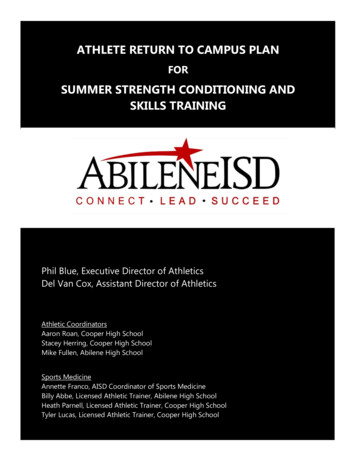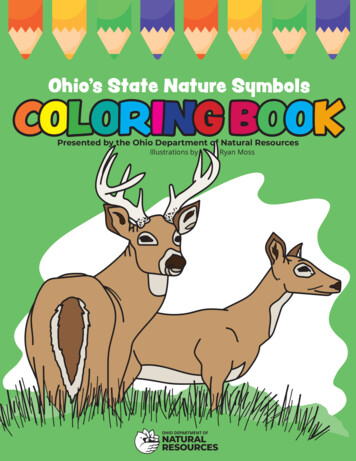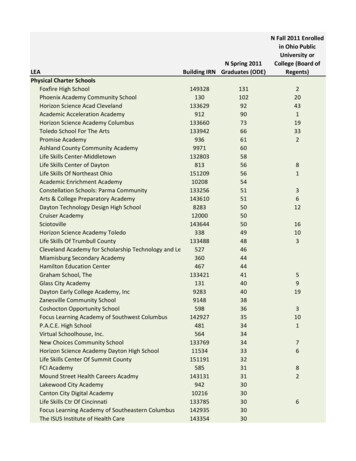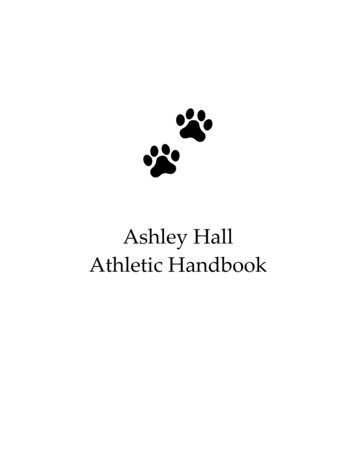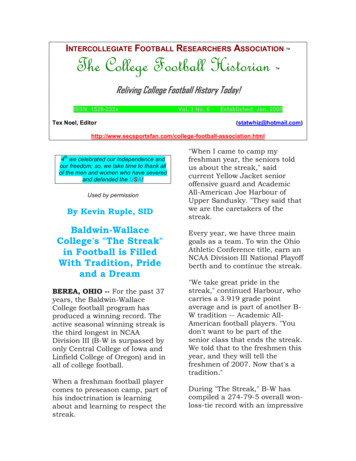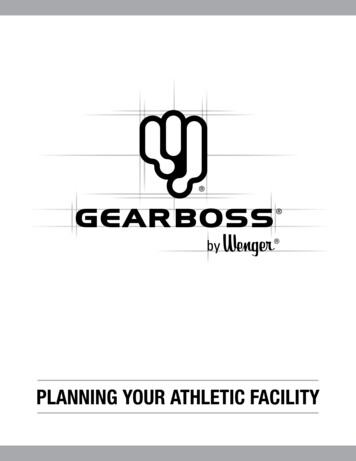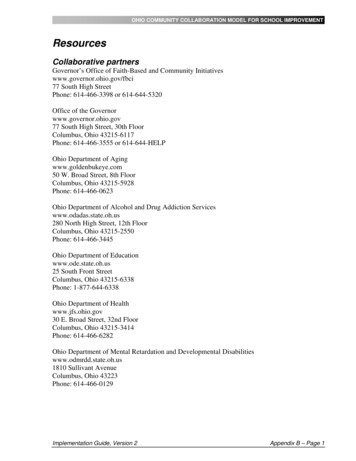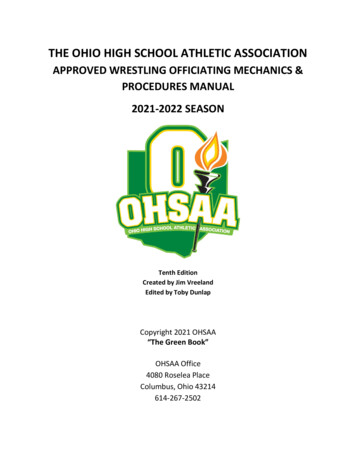
Transcription
THE OHIO HIGH SCHOOL ATHLETIC ASSOCIATIONAPPROVED WRESTLING OFFICIATING MECHANICS &PROCEDURES MANUAL2021-2022 SEASONTenth EditionCreated by Jim VreelandEdited by Toby DunlapCopyright 2021 OHSAA“The Green Book”OHSAA Office4080 Roselea PlaceColumbus, Ohio 43214614-267-2502
ATTENTION“This Mechanics and Procedures Manual Are Accepted As Standard PracticeFor Ohio High School and Junior High School Levels.This mechanics manual is written to provide every Ohio scholastic wrestling referee consistentexplanation of the why’s and how’s to institute proper procedures and mechanics while officiating. Ourscholastic referees work with young junior high and high school men and women who range in age fromabout 13 to about 18 years. These young student athletes are at various stages in terms of their physicaland psychological development. These attributes play a pivotal role in how our scholastic wrestlingofficials evaluate every wrestling match.For a variety of safety reasons, the Ohio High School Athletic Association through their StateRule Interpreters and the Director of Officiating Development follow strict mechanicsand accepted procedures that all Ohio wrestling referees must abide by.Ohio scholastic wrestling referees are a team. Each team member must strive for consistency.Consistency involves every aspect of the sport and begins with the first weekend of the season.DO IT RIGHT FROM YOUR FIRST MATCH TO YOUR LAST MATCH OF THE SEASONBeau Rugg, OHSAA Director of Officiating and Sport ManagementTyler Brooks, OHSAA Senior Manager of Officiating and Sport AdministrationCharles Anderson, OHSAA Manager of OfficiatingToby Dunlap, OHSAA Wrestling DOD & SRIRay Anthony, OHSAA Wrestling SRIDick Loewenstine, OHSAA Wrestling SRIJim Vreeland, OHSAA Wrestling SRIThe OHSAA is grateful to the NFHS for the courtesy of permitting the use of the illustrations set forthon pages 45 to 48 of this manual.1
TABLE OF CONTENTSBiting . .Flagrant Misconduct . . . Blood, Injury & Recovery Time . Mechanics Signals . . . . .Captains, Disc Toss & Reporting to Mat . . . .Coach Must be Present to Begin Match . . .Concussion Protocol . Conference . . . Correction of Errors . . . .Fleeing . . .Ejection and Ejection Report Protocol . Mechanics/Hand Signals . . . .Neutral Position Mechanics . . .Assistant Referee . .NFHS Out of Bounds & Supporting Points Criteria . NFHS Skin Form . .OHSAA Body Fluid (blood) Clean-Up Policy & Protocol . .Potentially Dangerous Situations . . Pre-Meet Duties . . Locker Room Visit . .Referee’s Position . . . Assistant referee Near Fall Mechanics Referee’s Uniform . Special Equipment, Braces & Sleeves . .Stalemate . . . .Stalling . . .Neutral . Offensive . Defensive . .Technical Violations . .Warning or Penalize . . .Weigh-Ins . .Who to Contact 526262733449The tenth edition of the MECHANICS & PROCEDURES MANUAL (The Green Book) is dedicated to Ohio's scholasticWRESTLING OFFICIALS who work hard on behalf of the Ohio wrestling community, particularly during theseunprecedented times. Contact the OHSAA Office at 614.267.2502 or Toby Dunlap, Director of OfficiatingDevelopment, at 440-487-6308 concerning questions or suggestions relating to this manual.2
OHIO WRESTLING OFFICIAS MECHANICS, POSITIONING & PROCEDURESMANUAL“THE GREEN BOOK”REFEREE’S UNIFORM Required Uniform:oooooooooThe gray pin stripe shirt is completely mandatory.The American flag on the left shoulder with a green OHSAA logo on the left breast area of theshirt.Black full-length trousers, black socks, black officiating shoes and black belt if necessary.Emblems and patches are not permitted on the officiating uniform. Exception: An American flagpatch/emblem is optional and, if worn, shall be on the left sleeve approximately two inches belowthe shoulder with the star field facing to the front.Jewelry shall not be worn except for a wedding band and/or a medical alert necklace or bracelet.A religious medallion which is not visible is permitted. A watch/timing device is permitted onlywhen an official has a duty for timing during the contest and shall be worn under the wrist band.A black warm-up jacket with OWOA logo is required for all varsity officials.Red & green wrist bands, colored flip disc, recommend a black plastic whistle with a blacklanyard.The whistle must be loud enough to be heard at large multi-team events. A black plastic pea-lesswhistle is recommended for use. Every official should carry an extra whistle in his/her jacket.It is imperative that all officials arrive on site appropriately dressed, well-groomed with facial hairneatly trimmed.FOUR IMPORTANT ISSUES Please pay attention to the following:ooooConcussion protocol (ORC 3313.539 and ORC3314.03) - Concussion protocol certificate must berenewed every third year.Contagious skin conditions; Dermatologist’s note.Potentially dangerous calls – the athlete’s safety is paramount.Ohio's middle school level consists of 7th & 8th grade athletes. Sixth graders and under areprohibited from competition at the middle school level.PRE-MEET DUTIES Confirm your officiating assignment at least 5-days before the scheduled event with the A.D. of the hiringschool.Appear at event site dressed appropriately.o The referee has jurisdiction over the event once he/she arrives at the site.o Shirt and tie are nice if coming directly from the workplace,o Raggedy jeans with holes and T-shirt do not set the correct tone.Upon arrival immediately find the Athletic Director/Event Manager/Wrestling Coach.3
First introduce yourself. Example: “Good evening, I’m the wrestling referee assigned to tonight’smatch. Could you please direct me to the locker room to find the Wrestling Coach?o The referee should arrive a minimum of one hour prior to the start of the match. You may wantto appear at the host school a little earlier, if involved w/weigh-ins to give yourself enough timeto find the locker facility and get into uniform.o Being properly groomed and dressed, with warm-up jacket on sends the appropriate messagethat you are a professional and you take your responsibility seriously.o The referee’s responsibilities begin by conducting the random draw to establish weight class orderfor dual meet events.o It is appropriate for the official ask the visiting coach to make the random draw selection.o The random draw may also be used to establish the first weight class to begin the weigh-in.The wrestling referee needs four pieces of equipment; black lanyard & whistle, red & green wristbands, arandom draw kit and a colored flip disc. It is also advisable to carry a spare whistle in your warm-up jacketpocket.The referee has full authority in overseeing the wrestling match. Every referee must read/study theNational Federation Rule Book, the Case Manual and Green Book on a regular basis. Every referee shouldbe comfortable applying the rules based on criteria to support each call.Use good judgment and apply sound common sense when necessary. Treat those you meet with respect,dignity and in a well-mannered tone of voice from the moment you enter the building. Act and conductyourself the way you would like to be treated. Be confident from the beginning, and proud of the job youdid as you drive away.o WEIGH-INS & GROOMING CHECK(Copy of Skin Form is on page 39 of this Manual) The OHSAA has adopted the NFHS 14 weight class option for the 2021-2022 season (a year earlier thanrequired by NFHS Rule 4-4-1).May weigh in with socks & require all participants to present any special equipment at the weigh-in.During the pre-meet duties it is important to ask the coaches several questions.o Ask if there are any valid physician’s notes for any athletes who have a suspected skin condition.o A physician’s note must be on the NFHS approved skin form and be present in the weigh-inroom when it is requested.o Coach may not take wrestler to the local ER then return with a note.o The coach is responsible to check athletes regularly for potential skin conditions.o The referee is the last line of defense to mitigate the spread of any contagious skin condition.o Skin forms must be the original form signed by a physician A photocopy is not acceptable. The form must be signed by a physician (MD or DO).Forms may be signed by a PA or CNP who is associated with an OHSAA approved ShortNotice Dermatologist Practice (see OHSAA Wrestling page for approved practices). Do not accept a note on an Rx pad, or letter from a physician. Do not accept an electronic copy on a tablet, iPhone, or iPad, etc. The approved NFHS skin form must be properly completed. The note is unacceptable if: The suspected condition appears on places other than those marked on thebody pictogram. The suspected condition is still moist, oozing or scabbed over. The official has the authority to disqualify the athlete from competition ifhe/she is uncomfortable with the suspected skin condition.o The skin form is valid 10-days from the date of exam. Forms outside of this 10-day window arenot acceptable.4
Skin forms diagnosing non-contagious skin conditions (e.g., birthmarks, eczema, psoriasis,etc.) are valid for the entire season.If an MD or DO is the designated on-site physician, his/her decision is final over a form. There shall be noargument or disagreement with the designated on-site physician.If an MD or DO stipulates the athlete may wrestle if it is covered, ask “is the condition contagious?”o NFHS does not allow a contagious skin condition to be covered to wrestle.o If the physician says it may still be contagious, then the wrestler must be disqualified.Read the doctor’s note carefully and check the dates he/she has stipulated when the wrestler may returnto competition, along with the body pictogram.Many coaches carry their notes to every match, not knowing the referee, and how each may perceive theskin issue. The physician’s note must be present in the weigh-in room.Officials must be consistent in enforcing the suspected skin condition protocol.o The Ohio High School Athletic Association, as recommended by its Joint Advisory Committee on Sports Medicine,has adopted the policy to require a physician, defined as a medical doctor (MD) or doctor of osteopathy (DO), asthe authorized person to clear a wrestler for continued participation in this sport. In addition, Certified NursePractitioners (CNP) or Physician’s Assistants (PA) who work in an OHSAA approved Short Notice DermatologistPractice as identified on the list found on the link below are eligible to sign the skin form and return the studentto SPECIAL ACCOMODATIOINS FROM OHSAA:oooo Special needs may require the OHSAA to issue an accommodation letter to allow specialaccommodation(s) for some athletes to participate. The coach must present the official withthe accommodation letter prior to weigh-in.Special accommodations may include but not limited to the following: youth ankle monitor,medical devices, medical monitors, prosthetic appliances, as well as accommodations for blind,deaf and transgender wrestlers.The official simply needs to follow the specific directions set forth in the accommodation letter.The OHSAA issued special accommodation letter is valid only for the sport season in session.Begin the inspection of contestants,ooooRemember the inspection is to make sure the wrestlers comply with a set of grooming, healthand safety standards promulgated by the NFHS/OHSAA.These health standards ensure that contestants, referees, tappers, etc. all have a safeenvironment in which to participate.Inspect the athletes before the coach/trainer does any taping.Suggested order of inspection:A. Check fingernails,B. Check hair (there is no longer a hair length rule) Mustache Beard Facial stubble Shaved heads (abrasiveness) – may wear an approved hair covering in lieu of shavingthe scalp.C. Continue the skin inspection by thoroughly scanning down the length of the body. Get in the same rhythm or pattern as you move through the line-up. Look around the front and side of the face & forehead. Check under the chin to look in the back of neck region & hair line.5
Inspect the scalp (do not touch the athlete) as skin conditions may be obscured by thehair.D. Ask the wrestler to raise the arms to examine the sides, under the armpits, and the undersideof the arms.E. With the front inspection complete, ask the contestant to spin around to begin the rear sideinspection. Start at the top, begin with the hair line to look for possible skin conditions on thescalp.F. Continue the skin inspection by looking carefully around the back of the neck, across theshoulders through the lower back, and complete the inspection with a close look at the back ofthe knees.When you find any part of the contestant inspection process (e.g., grooming issues) that does notsatisfactorily meet with your approval, tell the wrestler that he/she cannot compete until the issue isremedied.It is recommended that the weigh master place a capital M(mustache), N(nails), or S(shave), next to thename/weight class of a wrestler who does not pass the grooming inspection. NOTE: With the 2020-2021 NHFS Rules changes, hair length is no longer restricted. However, a wrestler maychoose to wear an approved hair cover or approved hair control devices. As in past practice, the hair covermust be attached to the head gear and shall not be abrasive. A legal hair control device must be made of amaterial that is soft and flexible. The referee must approve all hair covers and hair control devices prior tocompetition (at weigh-ins). The restrictions on facial hair have not changed. A contestant may compete withfacial hair if a face mask designed for wrestling (must completely cover the facial hair) is worn. A neatlytrimmed mustache that does not to extend below the lower lip is allowable. When a contestant has a suspected skin condition, it is important to address the situation withouthesitation, and in a professional manner. Some coaches and the wrestlers will begin to make a variety ofstatements dismissing the skin problem. “Oh, that’s a mat burn”, “It’s a pimple that I just squeezed”, “Thatwasn’t there yesterday”, “The referee (last weekend) didn’t say anything about it”, and the list continues.Pointers to handle possible contagious skin situations are as follows:o Don’t make statements suggesting what you think the skin condition is - You are not a physician.o You are the referee, and part of the referee’s responsibility is to identify a suspected contagiousskin problem for the safety of all who compete on the mat.o It is the coach’s responsibility to look out for the safety of his wrestlers. If a referee suspects thata contagious skin condition is present and a coach cannot present a valid skin form indicatingthat his/her wrestler is free of any contagious skin conditions, the referee must tell the coachand wrestler that he/she will not be allowed to compete in the match.o All referees should take the necessary time to familiarize themselves with the characteristics ofskin problems. Today’s wrestling referee should be familiar with the signs of potential ringworm,impetigo, shingles, scabies, herpes, MRSA, and staph conditions.o Without an on-site physician, the match referee has the jurisdiction and the authority not toaccept a NFHS skin form if it is not properly completed, if it is a copy, written in a letter form,written on a Rx pad, new areas of concern not depicted on the body pictogram on the NFHS skinform, and/or the existing condition appears unsafe for competition.o If a physician is present and states a wrestler may compete if a specific skin condition is covered,the official must ask: “Doctor, in your opinion may this condition still be contagious?” If hisanswer is YES, the official must inform the doctor that NFHS rule does not permit a wrestler tocompete merely because the condition is covered. The wrestler cannot compete and must bedisqualified.o All contestants must weigh-in wearing a legal uniform with appropriate undergarment(s) thatcompletely covers the groin and buttocks. Additionally, female contestants must wear a sportsbra or a form-fitted compression undergarment that completely covers the breasts. Socks maybe worn but may not be removed (once on the scale) as a means of making weight.6
All contestants must wear an appropriate undergarment(s) that completely covers the groin andbuttocks during competition. For females this includes a sports bra and/or a form-fittedcompression undergarment that completely covers the breasts based on NFHS rule.Upon completion of the weigh-ins, the referee should sign the weigh-in sheet, so all coaches have averified weigh-in record for weight certification compliance.o NOTE: There is a growing number of female wrestlers competing with wrestling programs at all levels. The samerules apply to all wrestlers regardless of gender. NFHS Rule 4-5-7 requires all wrestlers to weigh-in wearing a legaluniform with suitable undergarments. This modification simplifies the weigh-in process by allowing all thecompetitors (male and female) in the same area to expedite the weigh-in process. The rule modification eliminatesthe necessity to have an adult female present for separate weigh-ins. Skin and grooming checks are a separateprocess than weigh-ins. They may be conducted before or after weigh-ins at the referee's discretion.Special Equipment, Braces: Safety for the opponent is of primary concern.The rules and regulations with respect to all braces are the same. Itemized below is a list of guidelines andrestrictions for evaluating the legality of special equipment including braces. It is important to remember theregulations are as important for the wrestler wearing the brace as much as they are for the opponent. All bracesfall under the special equipment rules (4-3-1 thru 4-3-6). Often a neoprene sleeve is enough to help knee issuestay snug and keep the knees warm though competition. A neoprene sleeve without a hole in the front (for safetywith fingers sliding in) usually will suffice.For braces that have hinges, carbon fiber parts and metal rods along the sides: The wrestler with the brace must have full and complete range of motion with the device. The device must be covered and padded with a minimum of one-half inch of resilient foam. Velcro straps must be covered to prevent fingers from getting caught. A long, tight-fitting neoprene sleevewhich covers the complete length of the brace is the best protection for the wearer and the opponent.Any sleeve must be snug fitting on the body, and not be loose or rotate around the limb. The opponent'sgrasp must not slip or slide when holding the sleeve. The device and protection sleeve may not be large and cumbersome so as to impede the opponent fromcompeting fairly. He/she must not be put at a disadvantage. Knee devices may not restrict the wrestler from getting set in the bottom position. That is, the devicemust allow the knees to be parallel to the rear starting line (again not overly cumbersome). The match official at each event has the final say as to the legality of all special equipment. All specialequipment devices must be shown to the official at the weigh-in.Full length leg/arm sleeves are not permitted; they hinder the opponent. Knee and elbow pads are legalif the containment sleeve extends from approximately mid-thigh to approximately mid-calf or from approximatelymid-upper arm to approximately mid-forearm, respectively. As a guideline, the knee/elbow pads may extendapproximately 4” above the knee/elbow to approximately 4” below the knee/elbow. The knee/elbow pad itselfmust be integral (contained within) with the sleeve. The knee/elbow pad may not be a separate “slide over” or“slide under” pad relative to the sleeve. Full length arm and leg sleeves are illegal.INSPECT THE WRESTLING AREA When weigh-ins conclude the meet referee should walk the wrestling mat and inspect the mat andmarkings.Also inspect distance/proximity and relationship to the team benches, the scorer’s table and the wrestlingarea.Make sure there is at least five (5) feet of fringe protection mat around the competition area.7
While on the floor, remember to review timer and scorekeeper (home and visitor) duties with therespective table worker staff.o Important not to let anyone interfere with the team at the table. They must not be distracted.o Ask all table workers to put their electronic devices away. This includes, but is not limited to thefollowing: cell phones, tablets, iPads, iPods, smart phones, laptop computers, etc.o Support the team at the table (emphasize teamwork) - they can make or break the continuity ofthe match.o It is important to emphasize "checks and balances" between the timer, the home team scorer(official scorer) and the visiting scorer. Confirm running match score and cumulative team scoreduring and following each match with one another.Note: Not only should the table workers keep electronic devises put away, that also goes for the officials. It looksinappropriate for a sports official sitting at the table playing cell phone games while all around him/her a scholastictournament is being contested. The NFHS and OHSAA expect all to pay 100% attention to the task of being anofficial at the event.LOCKER ROOM VISIT/TALK This needs to be 3 to 5-minute process. You get one chance at a first impression. Do not give a dissertation(keep it short & sweet).This is the final time and place to impress upon the teams with that you are a professional and in-chargeof the match.After inspecting the wrestling area, and talking with the table, it is important to visit each team in theirlocker room to set down a few ground rules. This begins by asking the coach if his team is properlyequipped and ready to wrestle. When the coach replies “yes”, he/she is acknowledging that he/she isaccountable and that his/her team is legally equipped and ready to compete, for example:1. The wrestlers are all wearing a legal under garments.2. Any taping is legal and will allow normal legal holds & full range of motion.3. Uniforms and shoes are legal, shoelaces are properly secured with all eyelets laced (e.g.,secured in a zipper pouch, a Velcro flap, double knotted, taped around the ankle, or individuallytaped).4. There is no pass on the first offense for laces not being secured.5. Headgear (may cross straps w/ ear holes open) and kneepads are legal (no loose knee pads)6. No tape on head gear or shoes (except to secure shoelaces).The pre-match instructions to the wrestlers/coaches prior to the start of the match may include, but isnot limited to the following:o Remind the wrestlers they are to wrestle aggressively for six-minutes, and work in the centercircle.o Remind all contestants of three basic commands “Center - Action - Contact”o Ask if there are any questions and wish the team good luck.o We make the end of the season easier for each other if we take the extra time at the beginningof the season to do-it-right!o There are always a few new rules changes that occur for the season. The pre-meet visit is a goodforum to clear-up questions on new rules implementations and interpretations.8
CAPTAINS/COIN TOSS/REPORTING TO THE MAToooooIn the center of the mat, meet with the team captains.Remind them they are to assist the coach with sportsmanship from the team bench.The proper procedure is to ask a visiting captain to call the color of the disc (NFHS 1978-79 “callthe coin”).Winner of the disc toss has choice of even or odd matches, with the first match determined bythe random draw. Always allow the disc to hit the wrestling mat.Wish the captains Good Luck and start the match.Reporting to the Mat: Make sure that the correct wrestlers have reported for check-in at the scorer’s table.Double check to ensure that the proper wrestlers and weight class have reported directly to the center ofthe mat.Make sure that the wrestlers are legally equipped, properly groomed, and ready to wrestle.Ensure that both wrestlers extend their right hands for a proper pre- and post-match handshake.Dual Meet Reporting for Competition: Based on the disc toss and captains even/odd selection, teams alternate sending their competitor tocheck-in at the scorer’s table first.First to check-in may be critical to the outcome of the dual meet.o If the wrong wrestler reports first, he/she may be withdrawn prior to stepping in the 28’ circle.o Once the correct wrestler has reported in proper order, if he/she is withdrawn it shall be a forfeit,and that wrestler is eliminated from further competition.When the correct wrestler checks-in with the scorer, the opponent may continue to the mat or bewithdrawn and replaced with another opponent.If either wrestler avoids the check-in at the table and proceeds directly into the 28’ competition circle,he/she has presented himself/herself as the next competitor and may not be withdrawn. The only waythe wrestler may be withdrawn is reporting out of sequence. Example: the 165-weight class is next tocheck-in, inadvertently the 175-weight class wrestler appears to wrestle. This out of weight class sequenceand the wrestler must be withdrawn (without consequence).REFEREE MECHANICS IN NEUTRAL SITUATIONSWrestler’s Position in Neutral Start: Both wrestlers must place one foot on their respective starting line and the other foot on or behind theline or the line extended.Hands and/or foreheads cannot touch the opponent.Wrestlers must be standing on two points, no other body parts touching the mat in front of lead foot (nofootball stance).Both wrestlers must be stationary until the whistle sounds (no rolling starts).Start of the Match: Make sure wrestlers are in proper position and stationery.The referee should step in between the wrestlers with an outstretched arm between the red and greenstarting lines. Make sure this position does not interfere with the wrestlers, either their view each otheror by touching the athletes. The referee should be stationary and facing the scorer’s table.o Make eye contact with the timekeeper.o Sound your whistle and simultaneously make a visual hand/arm motion to start the match.9
Move out quickly and back your way towards outer boundary line.Glance up momentarily to ensure that the clock has properly started.Always keep both wrestlers in your line of sight as you back out.The whistle should remain in the official’s mouth.Neutral Standing Position: Situate yourself so that you are far enough away from the wrestling to observe the action and not interfere with sudden changes in position.Be close enough to immediately reposition yourself to stop potentially dangerous and illegal maneuvers.Six to nine (6-9) feet is suggested, find your comfortable zone. A wider range allows greater perspective.Know how various takedowns finish so you know where to position yourself to stay out of the way and toobserve control as it is established.Always situate yourself to be centered and able to look between both wrestlers as they face each other.o Anticipate change of position.o Do not chase the action; stop and let the action come back to you.o Sometimes moving counter to the wrestlers’ rotation is more effective.o Square yourself to the action.Change levels and be mobile in order to be in proper position to observe (bend knees – drop hips).It is important to loudly verbalize the award of takedown points to afford the opportunity to the scoringwrestler to release the locked hands without penalty.Award points in a confident manner using approved hand signals with eye contact maintained strictly onthe athletes. Trust the table team to do their job correctly - focus on the wrestlers.When awarding points ensure that your arm is situated straight above your head. Rotate your hand sothat the point(s) awarded are clearly visible from all angles.Boundary Line: On or near the boundary line, the referee should be positioned to observe the location of the supportingpoints of each wrestler. Straddling the line is one position and getting perpendicular to the wrestlers alsoaffords the referee a greater opportunity to catch the wrestlers beyond the boundary line - safety first.Call out-of-bounds by the letter of the rule and be consistent from call to call.o Use proper hand mechanics w/ simultaneous whistle.Always keep safety in mind.o Be ready to reposition yourself to protect wrestlers heading out-of-bounds.o May have to sound a pre-mature whistle when safety is a concern.When possible, on feet-in takedowns award the earned poin
random draw kit and a colore d flip disc . It is also advisable to carry a spare whistle in your warm -up jacket pocket. The referee has full authority in overseeing the wrestling match. Every referee must read/study the National Federation Rule Book, the Case Manual and Green Book on a regular basis . Every referee should

